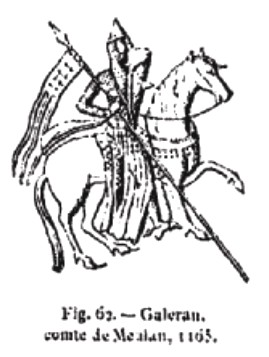
Roger Mortimer, 1st Baron Mortimer of Wigmore, of Wigmore Castle in Herefordshire, was a marcher lord who was a loyal ally of King Henry III of England and at times an enemy, at times an ally, of Llywelyn ap Gruffudd, Prince of Wales.

William de Valence, born Guillaume de Lusignan, was a French nobleman and knight who became important in English politics due to his relationship to King Henry III of England. He was heavily involved in the Second Barons' War, supporting the king and Prince Edward against the rebels led by Simon de Montfort. He took the name de Valence after his birthplace, the Cistercian abbey of Valence, near Lusignan in Poitou.

Montfort-sur-Risle is a commune in the Eure department in Normandy region in northern France.
Robert de Beaumont, 1st Earl of Leicester, Count of Meulan, also known as Robert of Meulan, was a powerful Norman nobleman, one of the very few proven Companions of William the Conqueror during the Norman Conquest of England in 1066, and was revered as one of the wisest men of his age. Chroniclers spoke highly of his eloquence and his learning, and three kings of England valued his counsel. He was granted immense land-holdings in England by William the Conqueror and by Henry I and was created Earl of Leicester.
The Canton of Pont-Audemer is a canton of the Eure département, in France.
Elizabeth of Vermandois, was a French noblewoman, who by her two marriages was the mother of the 1st Earl of Worcester, the 2nd Earl of Leicester, the 3rd Earl of Surrey, and of Gundred de Warenne, mother of the 4th Earl of Warwick.

Waleran de Beaumont (1104–1166) was an Anglo-Norman nobleman. In his early adulthood, he was a member of the conspiracy of Amaury III of Montfort; later in his career, he participated in the Anarchy and the Second Crusade. During the reign of Henry II of England, Waleran's close ties to Louis VII of France caused him to fall out of grace.

William the Conqueror had men of diverse standing and origins under his command at the Battle of Hastings in 1066. With these and other men he went on in the five succeeding years to conduct the Harrying of the North and complete the Norman conquest of England.
Gilbert de Gant was the son of Ralph, Lord of Aalst near Ghent, and Gisele of Luxembourg, the sister-in-law of Baldwin IV, Count of Flanders. Gilbert de Gant was a kinsman of Matilda of Flanders, wife of William the Conqueror. He had two older brothers, Baldwin and Ralph. Gilbert of Ghent is mentioned in the Domesday Book of 1086 as having been given titles of 172 English manors but also within 14 shires where there were estates including York, Derby, Huntingdonshire, Leicestershire and Cambridgeshire.

The House of Tosny was an important noble family in 10th and 11th century Normandy, though it did not include any comtes or vicomtes. Its founder was Raoul I of Tosny.
When the Viking chieftain Rollo obtained the territories via the Treaty of Saint-Clair-sur-Epte which would later make up Normandy, he distributed them as estates among his main supporters. Among these lands were the seigneurie of Harcourt, near Brionne, and the county of Pont-Audemer, both of which Rollo granted to Bernard the Dane, ancestor of the lords (seigneurs) of Harcourt. he first to use Harcourt as a name, however, was Anquetil d'Harcourt at the start of the 11th century.
Giroie, Lord of Echauffour and Montreuil-l'Argillé, was a knight from Brittany who became a Norman nobleman and the progenitor of a large family in Normandy, England, and Apulia.
The Council of Lillebonne was a meeting of the nobles and clergy of Normandy where, among other things, the expedition of William the Conqueror, then Duke of Normandy, was approved. It was held at Lillebonne, in the northeast of Normandy. Wace, the 12th-century historian, wrote of the council, convened shortly before the actual invasion, likely in January 1066. William of Poitiers, a chronicler of the Norman invasion, claims that the duke also obtained the consent of Pope Alexander II for the invasion, along with a papal banner.
Vauquelin (Walkelin) de Ferrières, Seigneur of Ferrières-Saint-Hilaire. The Ferrers family holding at Ferrières-Saint-Hilaire was the caput of their large Norman barony.
Hugh de Montfort (Hugh II) (died 1088 or after) was a Norman nobleman. He was Lord of Montfort-sur-Risle, Constable of Normandy and a companion of William the Conqueror. Hugh's father was killed in combat with Valkelin de Ferrières in 1045.
The House of Clermont is a noble family of the French region of Picardy dating from the 10th century and included both the early counts of Clermont-en-Beauvaisis as well as many Constables of France. The house eventually merged with the House of Nesle with the marriage of Raoul II of Clermont and Gertrude of Nesle. The family is the sometimes referred to as the House of Clermont-Nesle.
The armies of Bohemond of Taranto, formed in 1097, include a major component of the First Crusade. He is regarded as the real leader of the First Crusade. He formed a second army in 1107 to defend Antioch but instead used it to attack the Byzantine emperor Alexios I Komnenos, resulting in the Treaty of Devol, codifying Bohemond’s defeat. Runciman estimates that the first army included 500 cavalry and 3500 infantrymen and other estimates that the second army was at 34,000 personnel strength are likely greatly exaggerated.
Simon III de Montfort, nicknamed the Bald, was count of Évreux from 1140 until 1181 and the Seigneur of Montfort from 1137 to 1181. He was the son of Amaury III and Agnès de Garlande, daughter of Anseau de Garlande.
Walter de Gant, Lord of Folkingham was an English nobleman.





